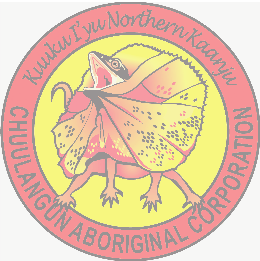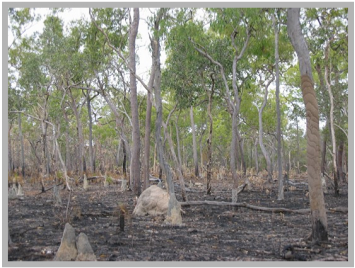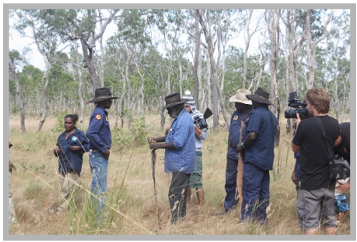


HOME | ABOUT US | HOMELANDS DEVELOPMENT | NRM | CULTURAL HERITAGE | PROJECTS | CAMPGROUNDS | MEDIA | LINKS

HOME | ABOUT US | HOMELANDS DEVELOPMENT | NRM | CULTURAL HERITAGE | PROJECTS | CAMPGROUNDS | MEDIA | LINKS

A lack of control of land management on our homelands has resulted in deleterious fire management regimes being broadly applied to Kaanju estates, which is of concern to traditional owners and our families currently residing on homelands. There is a history of exclusion of Kaanju people from non-Aboriginal discussions of fire and no attempt has been made to develop an understanding of Kaanju perspectives on fire, nor to develop methodologies for collaborative fire management. Chuulangun Aboriginal Corporation has recently completed a report Kaanju Fire Management 2003, funded by the Cape York Peninsula Development Association (CYPDA) Fire Project through Balkanu Cape York Development Corporation, which should go some way to rectify this problem.
The report investigates a number of issues, including:
(1) Kaanju people have an existing fire management science, based on thousands of years of knowledge and practice, which has been transferred through ancestral bloodlines to the contemporary knowledge and practice.
(2) Western science and government need to acknowledge indigenous fire management knowledge and practice as a legitimate science and recognise the primacy of Kaanju management on homelands.
(3) According to Kaanju governance structures there are certain people who have responsibilities to burn and these people need to be resourced to practice their existing fire management.
(4) Kaanju people are concerned about current imposed fire practices, in particular technical tools such as satellite imagery that take photographs of people's homelands without permission, and are ineffectual for on-ground management.
We are currently developing a fire management strategy and the basic structure is outlined in our Kaanju Homelands Land and Resource Management Framework.
The report investigates a number of issues, including:
- Current fire burning regimes on Kaanju homelands.
- Kaanju view of current fire research.
- Kaanju priorities for fire research and how research should take place.
- How Kaanju people wish to see fire management take place on country and recommendations, including current constraints.
- Resources required for appropriate fire management on Kaanju lands.
- Evidence of any habitat change from changed burning regimes.
(1) Kaanju people have an existing fire management science, based on thousands of years of knowledge and practice, which has been transferred through ancestral bloodlines to the contemporary knowledge and practice.
(2) Western science and government need to acknowledge indigenous fire management knowledge and practice as a legitimate science and recognise the primacy of Kaanju management on homelands.
(3) According to Kaanju governance structures there are certain people who have responsibilities to burn and these people need to be resourced to practice their existing fire management.
(4) Kaanju people are concerned about current imposed fire practices, in particular technical tools such as satellite imagery that take photographs of people's homelands without permission, and are ineffectual for on-ground management.
We are currently developing a fire management strategy and the basic structure is outlined in our Kaanju Homelands Land and Resource Management Framework.






In 2009-11 Chuulangun Aboriginal Corporation prepared a fire management and carbon abatement strategy for the Kaanju Ngaachi IPA and the wider Kuuku I'yu Northern Kaanju Ngaachi. The aim of the strategy is to recover traditional fire management on Kuuku I'yu Ngaachi, and investigate the potential of this recovery to reduce greenhouse gas emissions. A copy of this document is available upon request from the Chuulangun Aboriginal Corporation.
Kuuku I'yu Northern Kaanju Fire Management Strategy
Kuuku I'yu Northern Kaanju Ngaachi is a tropical monsoonal environment, with a long dry season and a shorter wet season where a mean of approximately 1300mm of rain falls in four months. Most of the 800 000 hectares is fire-prone eucalypt savanna, with small areas of rainforest and other fire-sensitive vegetation types. It is almost completely vegetated and of great biocultural diversity importance.
A long tradition of fire management was broken during the assimilation era, when Kuuku I'yu people were taken away from their homelands under the protection and assimilation eras of government. The legacy is a dominance of larger fires in the late dry season, which threatens biodiversity and increases greenhouse gas emissions. Late fires accounted for 93.7% of the area burnt on the two major Kuuku I'yu properties studied in 2004-2008. Late dry season fires are a threat to biodiversity, including species such as Kila (Palm Cockatoo), which in Australia is only found on Cape York Peninsula.
Traditional Kuuku I'yu fire management focuses on fires lit in the early dry season, which were less intense and extensive. These earlier fires are placed for a range of reasons, including travel, hunting, safety, protection of fire sensitive environments from later fires, and to create a more open savanna environment that is suitable for a range of wildlife. In 2008, the 197 500 hectare Kaanju Ngaachi IPA was declared over about 25% of Kuuku I'yu, which recognizes and resources the Chuulangun Rangers to manage this area of country again. The traditional burning that has occurred around Chuulangun community in the last 10-15 years can now be conducted more widely.
If the return of traditional fire management reduces the annual extent of fires on Kuuku I'yu, as it probably will, there will be lower greenhouse gas emissions, fewer damaging large-scale fires, and probably reduced damage to fire-sensitive rainforests and improved biodiversity. This greenhouse gas abatement undertaken by the proper Traditional Custodians for Kuuku I'yu Northern Kaanju Ngaachi, through the Chuulangun Aboriginal Corporation, represents a commercial opportunity that could be used to invest back into a permanent Kuuku I'yu fire management workforce.
A lobbying effort is needed to ensure that Cape York Peninsula environments are recognized in Australian government greenhouse accounting as "savanna woodland" rather than the current "savanna grassland", which is inaccurate and may greatly underestimate the likely fuel load of Kuuku I'yu country, which is predominantly eucalypt savanna, and hence underestimate the current and projected greenhouse gas emissions.
Fire management workforce
The fire management workforce needs to have a combination of local knowledge of vegetation and weather dynamics, on-ground bush skills, computer skills, and project management and reporting skills. There is year-round work to be done once reporting and monitoring are in place. This work includes the fire conduction itself, but also the maintenance of a firebreak network, late dry season patrols, weed control, fire reporting and mapping, weather, vegetation and biodiversity monitoring. The estimated value of the greenhouse abatement would fund a workforce of four permanent staff and six seasonal staff, as well as vehicles and equipment for fire practice, weed management, monitoring and reporting.
Successful fire management on Kuuku I'yu will result in:
Chuulangun Fire Workshop
In July 2010 we hosted a fire workshop on the banks of the Wenlock River. The workshop was supported by Traditional Knowledge Revival Pathways (TKRP). Over 70 people attended the workshop from across Australia and overseas. Attendees included the Lamalama rangers, New South Wales Rural Fire Service, researchers, CSIRO and Indigenous fire practitioners.
Rangers also undertook valuable networking with other Indigenous ranger groups and other attendees from various backgrounds and undertook accredited CALM training. Attendees took away lessons about Indigenous fire management and the important of reviving traditional fire management practices to reduce devastating hot late dry season fires and reducing carbon emissions.
Kuuku I'yu Northern Kaanju Fire Management Strategy
Kuuku I'yu Northern Kaanju Ngaachi is a tropical monsoonal environment, with a long dry season and a shorter wet season where a mean of approximately 1300mm of rain falls in four months. Most of the 800 000 hectares is fire-prone eucalypt savanna, with small areas of rainforest and other fire-sensitive vegetation types. It is almost completely vegetated and of great biocultural diversity importance.
A long tradition of fire management was broken during the assimilation era, when Kuuku I'yu people were taken away from their homelands under the protection and assimilation eras of government. The legacy is a dominance of larger fires in the late dry season, which threatens biodiversity and increases greenhouse gas emissions. Late fires accounted for 93.7% of the area burnt on the two major Kuuku I'yu properties studied in 2004-2008. Late dry season fires are a threat to biodiversity, including species such as Kila (Palm Cockatoo), which in Australia is only found on Cape York Peninsula.
Traditional Kuuku I'yu fire management focuses on fires lit in the early dry season, which were less intense and extensive. These earlier fires are placed for a range of reasons, including travel, hunting, safety, protection of fire sensitive environments from later fires, and to create a more open savanna environment that is suitable for a range of wildlife. In 2008, the 197 500 hectare Kaanju Ngaachi IPA was declared over about 25% of Kuuku I'yu, which recognizes and resources the Chuulangun Rangers to manage this area of country again. The traditional burning that has occurred around Chuulangun community in the last 10-15 years can now be conducted more widely.
If the return of traditional fire management reduces the annual extent of fires on Kuuku I'yu, as it probably will, there will be lower greenhouse gas emissions, fewer damaging large-scale fires, and probably reduced damage to fire-sensitive rainforests and improved biodiversity. This greenhouse gas abatement undertaken by the proper Traditional Custodians for Kuuku I'yu Northern Kaanju Ngaachi, through the Chuulangun Aboriginal Corporation, represents a commercial opportunity that could be used to invest back into a permanent Kuuku I'yu fire management workforce.
A lobbying effort is needed to ensure that Cape York Peninsula environments are recognized in Australian government greenhouse accounting as "savanna woodland" rather than the current "savanna grassland", which is inaccurate and may greatly underestimate the likely fuel load of Kuuku I'yu country, which is predominantly eucalypt savanna, and hence underestimate the current and projected greenhouse gas emissions.
Fire management workforce
The fire management workforce needs to have a combination of local knowledge of vegetation and weather dynamics, on-ground bush skills, computer skills, and project management and reporting skills. There is year-round work to be done once reporting and monitoring are in place. This work includes the fire conduction itself, but also the maintenance of a firebreak network, late dry season patrols, weed control, fire reporting and mapping, weather, vegetation and biodiversity monitoring. The estimated value of the greenhouse abatement would fund a workforce of four permanent staff and six seasonal staff, as well as vehicles and equipment for fire practice, weed management, monitoring and reporting.
Successful fire management on Kuuku I'yu will result in:
- A greater area burnt at the right time in the early dry season each year (i.e. usually before July 15)
- A smaller area burnt in the late dry season each year (i.e. usually after August 1), and hence lower release of greenhouse gases into the atmosphere
- Annual assessment of fire extent, habitat and biodiversity values
- Eradication of weeds that will otherwise increase fuel loads and threaten to undo traditional fire management
- A well-resourced workforce to conduct the activities required to achieve points 1 to 5
- A commercial agreement recognizing the contribution of the Kuuku I'yu to reducing greenhouse gas emissions
- A central forum where all current landholders on Kuuku I'yu and neighbouring groups can collaborate on fire management activities
- New information to western science on the response of the country and its biodiversity to traditional burning for use locally and more widely in northern Australia.
Chuulangun Fire Workshop
In July 2010 we hosted a fire workshop on the banks of the Wenlock River. The workshop was supported by Traditional Knowledge Revival Pathways (TKRP). Over 70 people attended the workshop from across Australia and overseas. Attendees included the Lamalama rangers, New South Wales Rural Fire Service, researchers, CSIRO and Indigenous fire practitioners.
Rangers also undertook valuable networking with other Indigenous ranger groups and other attendees from various backgrounds and undertook accredited CALM training. Attendees took away lessons about Indigenous fire management and the important of reviving traditional fire management practices to reduce devastating hot late dry season fires and reducing carbon emissions.


Protection of Significant Sites : Revegetation & Protection of Wenlock River : Kaanju Fire Management Project : Kaanju Ethno-ecology Project : Kaanju Homelands Indigenous Protected Areas Project :
Chuulangun Aboriginal Camp Grounds Proposal : Kaanju Oils Distillation Trial : Kaanju Weeds Project : Back
Chuulangun Aboriginal Camp Grounds Proposal : Kaanju Oils Distillation Trial : Kaanju Weeds Project : Back

Copyright 2003-06 by Chuulangun Aboriginal Corporation
C/- Post Office COEN Queensland 4871 Australia
Email: chuula@kaanjungaachi.com.au
Credits / Disclaimer
This page last updated 18-04-06
C/- Post Office COEN Queensland 4871 Australia
Email: chuula@kaanjungaachi.com.au
Credits / Disclaimer
This page last updated 18-04-06

HOME | ABOUT US | HOMELANDS DEVELOPMENT | NRM | CULTURAL HERITAGE | PROJECTS | CAMPGROUNDS | MEDIA | LINKS

Copyright 2003-15 by Chuulangun Aboriginal Corporation | ABN 74277585078 | Contact Us | Credits | Disclaimer | This page last updated 19/06/2015





